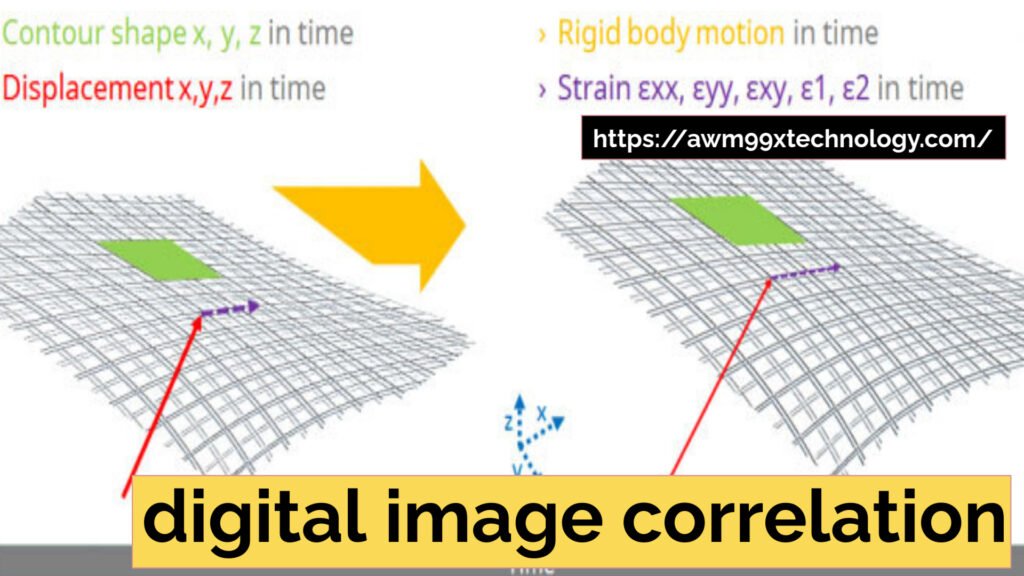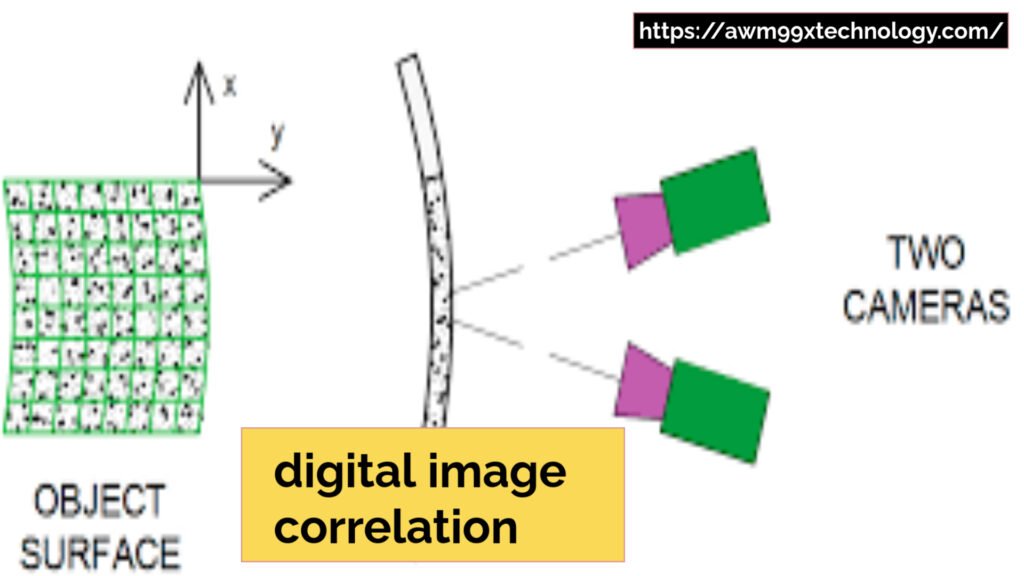Introduction
Digital Image Correlation (DIC) is an optoelectronic and advanced technology employed in the non-contact measurement of deformation, displacement, or strain of test materials and structures. This blog will discuss the finer details of DIC, its scope in various fields, and the advantages that come with it. We will also discuss the basic tools and software which enhance the use of DIC.

Points to include in the introduction
Definition of Digital image correlation
The need for a DIC in the testing processes and accuracy of measurements
General description of how DIC estimation works and its advantages
Brief introduction of the core technology and core tools which are applied in DIC.
Key Points
Definition of DIC: DIC is a very specific, non-threatening measuring process involving a device mapping the images to obtain movements over time to track changes in any structure or material.
Applications of DIC: DIC is applied in mechanical testing, structural health monitoring, and failure analysis. It is used in aerospace, automotive, biomechanics, and material science.
Benefits of Using DIC: DIC offers high precision, complete field’s measurements accurately and does not come into
direct contact with the specimen being tested which has an edge over conventional measuring techniques like strain gauges.
Technology Behind DIC:DIC systems typically include specialized hardware, such as high-resolution cameras, and feature software like Istoram4D. This software enables users to correlate data and images with sub-pixel accuracies.
Main Content
What is Digital Image Correlation?
Digital Image Correlation (DIC) is a non-contact optical method for monitoring the changing shape of a material through photographs taken at various loading points of the experiment. The general idea is that once a random pattern of speckle has been put on a surface and images taken of this surface at different points in time. The software examines these images in order to assess their movement or any deformation they may have experienced.
Basic concept of image correlation
Historical development of DIC technology.
How DIC differs from traditional measurement methods, such as strain gauges and displacement sensors, is important to understand. In contrast, DIC offers more detailed, high-resolution data.
How Does Digital Image Correlation Work?
DIC works through taking images of a speckle pattern that is placed on the surface of the material which is put under a load. As the material deforms, the software employs image correlation algorithms that track how the speckle pattern changes. This produces a full-field displacement map that reveals how the material behaved under load in
greater detail.
Image acquisition techniques: The use of high-resolution cameras to record the deformation of structure at its various
stages.
Some of the correlation algorithms used in the analysis: The program calculates strain and displacement based on the apparent and distorted images. Additionally, it uses these calculations to provide more accurate data.
Applications of Digital Image Correlation
The DIC method is helpful for measurement and analyzes in various sectors. The method is widely applied in structural health monitoring, biomechanics and materials testing where high precision non contact measurement is needed.
Structural health monitoring: Finding presence of cracks or weakness in the materials used for civil engineering and aerospace structures.
Biomechanics and medical applications: DIC is useful for determining biological tissue deformation during surgeries. Furthermore, it plays a key role in analyzing human actions.
Material testing and failure analysis: The properties of materials and their limit under stress are understood.

Benefits of Digital Image Correlation
DIC is significantly advantageous over other contact measurement methods such as strain gauges and extensometers. DIC be able to perform accurate and non-perturbing out-of-plane measurements on the specimen without subjecting it to force.
High accuracy and precision: Because of sub pixel accuracy, a very minute amount of distortion can be utilized to make very precise deformation measurements.
Non-destructive testing capabilities: DIC does not complete the specimen for testing. Instead, it provides detailed insights into the specimen’s behavior under stress.
Comprehensive coverage that covers the entire area of interest: DIC system uses non-contact measurements to provide an overview of the entire body of material, in contrast to other techniques that have a limited scope coverage.
Technology Used in Digital Image Correlation
DIC employs both hardware components and application software to get enhanced precision. The technology included high-resolution cameras, special lenses and software solutions such as Istra4D which integrates and retrieves critical information from the images taken.
Cameras and imaging systems used: During deformation and when various loadings are applied, high, speed and resolution cameras are utilized to examine the image during these stages.
Software for data processing and analysis: The software for analyzing image correlations is Istra 4D. Moreover, it provides the analysis images sequentially throughout the course of the test.
Comparison with Other Measurement Techniques
DIC Though DIC is a wonderful technique, its performance, like any other, should be checked with other older techniques such as strain gauges or laser scanning. All techniques have their pros and cons and knowing these can help decide when to use DIC as a technique of choosing.
Advantages of DIC: It is possible to perform measurements on the entire region of interest, provides increased measurement precision, and does not cause disturbance on the sample under investigation.
Limitations of DIC: The accuracy of the results depends on the image quality and surface features of the tested
material, particularly, the quality of the speckle pattern.
When DIC is preferred: DIC is best suited for the assessment of complex materials or structures which could be very difficult or very few are the accurate methods of testing.

Future Trends in Digital Image Correlation
The future development of DIC technology looks promising as there have been new improvements in both the hardware and software. Other developments are geared towards focusing on artificial intelligence and machine learning for automating image interpretation and enhancing measurement performance.
Integration with AI and machine learning: Better and faster algorithms for DIC will lead to speedy and accurate analysis of data.
Developments in imaging technology: Better and more effective imaging systems with the improvement of the quality of cameras that can capture finer details.
Case Studies Using Digital Image Correlation
DIC has been implemented in a variety of industries including the aerospace and automotive engineering sectors where the technology has been fundamental in enhancing the safety and efficiency of the
components.
Specific projects or experiments showcasing DICapplications: Case studies implemented in aerospace, automotive, and biomechanics.
Results achieved through the use of DIC:Accuracy levels of material testing improved, time and energy spent on material testing reduced production costs.
ALSO READ THIS BLOG : TECH ETRUESPORTS: THE NEW ERA OF SPORTS ANALYTICS AND INTERACTION
FAQs
What industries commonly use Digital Image Correlation?
Industries such as aerospace, automotive, civil engineering, biomechanics, and material science widely use DIC. Engineers and researchers apply it in mechanical testing, structural monitoring, and failure analysis.
How accurate is Digital Image Correlation?
DIC can achieve sub-pixel accuracy, allowing for precise measurement of deformation and displacement down to micrometer levels. This level of accuracy makes it ideal for high-precision testing.
Is Digital Image Correlation suitable for all types of materials?
DIC works well on most materials, but its effectiveness depends on the surface texture. Materials with a high-contrast speckle pattern yield more accurate results, while smooth or reflective surfaces may require additional
preparation.

What is Digital Image Correlation (DIC) in Python?
Digital Image Correlation (DIC) in Python is a technique that uses tools like OpenCV and NumPy to track how an object deforms. By comparing images of the object before and after it changes shape, DIC helps measure movement, strain, and displacement, making it useful for material testing and other applications.
What is Digital Image Correlation (DIC) Equipment?
| Component | Description |
| High-Speed Cameras | Capture high-resolution images of the object’s surface before and after deformation. |
| Lighting Systems | Provide uniform illumination to ensure clear image contrast for accurate tracking of surface features. |
| Image Processing Software | Analyzes the captured images, tracks pattern changes, and computes displacement, strain, and other mechanical properties. |
| Calibration Tools | Ensure accuracy by calibrating the system to account for camera positioning, lens distortion, and other variables. |
| Computing hardwere | Processes large volumes of image data, performs real-time analysis, and stores results for further evaluation. |
Conclusion
Digital Image Correlation or DIC does address one of the most fundamental aspects of modern material testing and structural analysis. It is also a great measure due to the fact that it entirely performance is non contact and is applied across various industries from aerospace, biomedical and more. Given how DIC technology is progressing, so
will the applications and advantages it brings for the engineers and researchers alike.
Points to include in the conclusion:
Recap the importance of DIC technology in non-contact measurement.
Emphasize its wide range of applications and benefits.
We encourage readers to explore DIC technology and integrate it into their practices to achieve better measurement accuracy.








2 thoughts on “Digital Image Correlation (DIC): 7 Ways It’s Revolutionizing Testing, Benefits, Applications, and Technology”